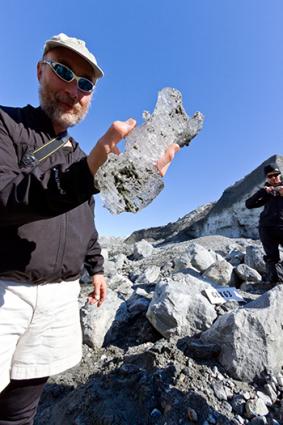East Greenland ice sheet has responded to climate change for the last 7.5 million years
 (Download Image)
Polar scientists Alice Nelson (University of Vermont), Dylan Rood (Imperial College) and Jeremy Shakun (Boston College) look over a frozen bay near Kulusuk, Greenland. Photos by Joshua Brown/University of Vermont.
(Download Image)
Polar scientists Alice Nelson (University of Vermont), Dylan Rood (Imperial College) and Jeremy Shakun (Boston College) look over a frozen bay near Kulusuk, Greenland. Photos by Joshua Brown/University of Vermont.
Using marine sediment cores containing isotopes of aluminum and beryllium, a group of international researchers has discovered that East Greenland experienced deep, ongoing glacial erosion over the past 7.5 million years.
The research reconstructs ice sheet erosion dynamics in that region during the past 7.5 million years and has potential implications for how much the ice sheet will respond to future interglacial warming.
The team, made up of researchers from Lawrence Livermore National Laboratory, University of Vermont, Boston College and Imperial College London, analyzed sediments eroded from the continent and deposited in the ocean off the coast, which are like a time capsule preserving records of glacial processes. The research appears in the Dec. 8 edition of the journal, Nature.
Understanding of early Greenland glaciation remains fragmentary, uncertain and for some periods, contradictory; much of what is known comes from marine sediments. The first presence of ice-rafted debris suggests that East Greenland glaciers initially reached the coast about 7.5 million years ago, whereas the surface texture of the sand grains suggests that glaciation began 11 million years ago.
"The East Greenland ice sheet has been dynamic over the last 7.5 million years," said lead author and University of Vermont scientist Paul Bierman. "Greenland was mostly ice-covered during the mid-to-late Pleistocene. At major climate transitions, the ice sheet expanded into previously ice-free terrain, confirming that the East Greenland Ice Sheet consistently responded to global climate change."
Using Lawrence Livermore’s Center for Accelerator Mass Spectrometry, LLNL scientist Susan Zimmerman and collaborators analyzed the isotopes of beryllium (Be) that were found in the quartz sand from ice-rafted debris in sediment cores.
Analyzing those isotopes in sediment shed from the continent and stored at the bottom of the ocean as marine sediment gives scientists insight into how Greenland responded to climate change in the past and how, in turn, it may respond in the future.
The concentration of cosmogenic nuclides in rock, sand and soil reveals the exposure history of the surface. Cosmic rays continually bombard Earth and produce aluminum (Al) and Be isotopes in mineral lattices. Production rates and nuclide concentrations decrease exponentially within a few meters of the surface, so covering a landscape with ice stops cosmogenic nuclide production in the underlying rock. Subsequent glacial erosion first removes the most highly dosed, near-surface material before excavating rock from depths containing progressively lower isotope concentrations.
Thermal conditions at the ice-sheet bed control its ability to erode, incorporate and transport rock and sediment. Warm-based ice can effectively erode rock and transport sediment to and off the coast, while cold-based ice, below the pressure melting point, is frozen to the bed and generally non-erosive; it buries and preserves ancient landscapes rather than eroding them.
The isotopic record in the new research thus focuses on the areas of the ice sheet that were warm-based.
Contact
 Anne M. Stark
Anne M. Stark
[email protected]
(925) 422-9799
Related Links
Center for Accelerator Mass SpectrometryUniversity of Vermont
Lab researcher discovers the green in Greenland
Consequences of today's carbon emissions will linger for thousands of years, study finds
Tags
ClimatePhysical and Life Sciences
Featured Articles









